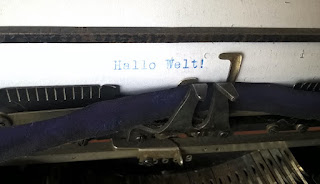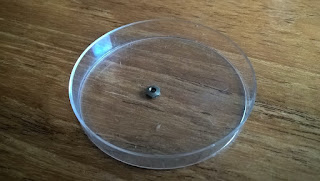Continuing the fixing-up and full cleaning of the Klapp-Erika; with the carriage-mishaps resolved, on to the escapement. Unlike the Standard Folding typewriter, the Erika has a full 'office-machine' escapement complete with star-wheel and intermediate pinion meshing with a rack on the carriage. The Standard (and Corona) solution is much more compact with the dogs working directly on a ratchet-rack on the carriage. This 'full-size' Erika escapement is even a sub-assembly that can easily be removed from the machine by undoing four screws.
In this cast-iron frame the star-wheel is mounted on an axle that is clamped between two adjustable bearings - for free running without play. The star-wheel itself also has a gear-face that meshes with an intermediate pinion held on a pivot-bolt in the escapement frame.
The pinion's pivot-bolt on this machine needed to be fixed with the lock-nut in just the right rotation-angle to give the gears a friction-free meshing. Some tweaking was needed to make it all fun freely. All parts were first cleaned (white spirit) and bearing surfaces given a polish as well.
After re-fitting the escapement in the typewriter, the little Erika was noticed to 'skip' and 'slip'. When very slowly pressing down the spacebar through its travel, the carriage would suddenly 'slip' and speed away rattling all the way to the left (as if seeking a tabulator-stop). Also, very occasionally the carriage would advance not 1, but 2 or more positions. These are escapement issues...
The problem very probably was already there before the cleaning, just not noticed - at any rate that'd make me feel better about it. When typing normally or pressing the spacebar with a 'normal' stroke, the carriage still functioned fine.
The slipping through the escapement suggested it was not a tripping-point issue, but rather the adjustment of the two dogs as they catch the star-wheel. The likely cause was that the edge of the fixed dog that catches the teeth of the star-wheel wore away just enough to give the star-wheel teeth room to slip between the loose and the fixed dog.
In the Erika's escapement mechanism, the loose dog is pulled by a little spring against the fixed dog - an anvil-surface at its side (green circle) resting against the fixed dog. I.e. there's no way to adjust the assembly to make the gap narrower to compensate for the rounding and wear of the fixed dog. The only way to reduce the gap was to reduce the anvil surface of the loose dog a few tenths of a mm.
With a grinding-stone in the 'Moto-Tool' and the loose dog held in a vise, the anvil-surface was ground down. Taking off a small amount at a time and then re-fitting and checking for the slippage, a minimal amount of material was removed. Just enough to stop the star-wheel teeth fitting between the dogs.
With some extra shimming under the sub-assembly to improve the meshing of the intermediate pinion with the carriage rack, the carriage escapement is now again mounted and working reliably.
The Erika folding typewriter is actually a nice mechanism to explore and tinker with - nearly everything is visible and easy to get at (notable exception being that pin hiding in te slot of the platen-flange). Most mechanical bits are bolted onto the outside of the typewriter - a machine :)





















